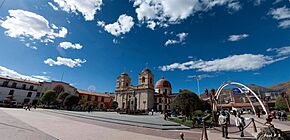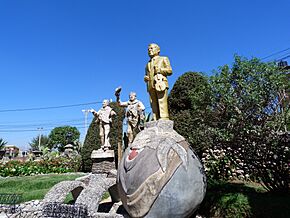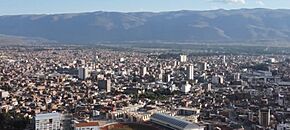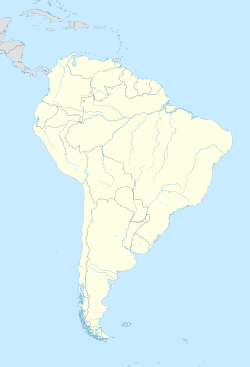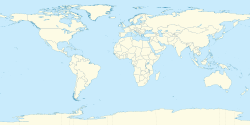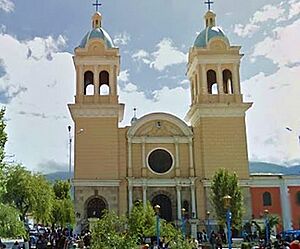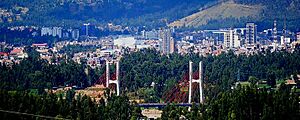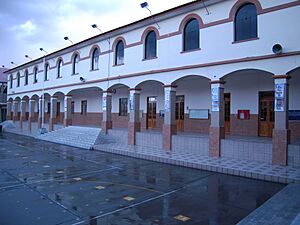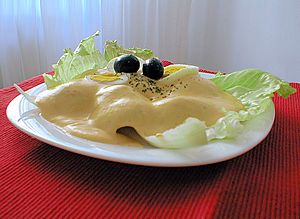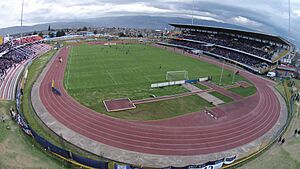Huancayo facts for kids
Quick facts for kids
Huancayo
|
|||
|---|---|---|---|
| Santísima Trinidad de Huancayo Holy Trinity of Huancayo |
|||
|
Plaza Constitución, Cathedral of Huancayo, Real Plaza Huancayo, Wanka Identity Park, Administration and Government Pavilion of the National University of the Center of Peru and Panoramic.
|
|||
|
|||
| Nickname(s):
"La Ciudad Incontrastable"
(The Uncontrastable City) |
|||
| Country | Peru | ||
| Region | Junin | ||
| Province | Huancayo | ||
| District | Huancayo | ||
| Founded | 1 June 1572 | ||
| Government | |||
| • Type | Municipal government | ||
| Area | |||
| • Total | 319.41 km2 (123.32 sq mi) | ||
| Elevation | 3,259 m (10,692 ft) | ||
| Population
(2017)
|
|||
| • Total | 456,250 | ||
| • Estimate
(2015)
|
364,725 | ||
| • Density | 1,428.41/km2 (3,699.58/sq mi) | ||
| Time zone | UTC-5 (PET) | ||
| • Summer (DST) | UTC-5 (PET) | ||
| Area code(s) | 64 | ||
| Website | www.munihuancayo.gob.pe | ||
Huancayo is a big city in the central highlands of Peru. It's the capital of the Junín Region and Huancayo Province. The city is located in the beautiful Mantaro Valley and has rivers like the Shullcas, Chilca, and Mantaro flowing through it.
Huancayo was officially started on June 1, 1572, by a Spanish explorer named Don Jerónimo de Silva. Its original name was Santísima Trinidad de Huancayo, which means "Holy Trinity of Huancayo." It's one of the highest cities in Peru, sitting about 3,256 meters (10,692 feet) above sea level. Huancayo is also the fifth largest city in Peru, with a population of around 500,000 people. It's known as a very important economic and social center for central Peru.
Long before the Inca Empire, around 500 BC, the Huanca people lived in this area. They even formed their own kingdom. Later, they became part of the Inca Empire. Huancayo was an important stop along the Qhapaq Ñan, which was the main Inca road system. Today, a part of this old road is called Calle Real. When the Spanish explorers, like Francisco Pizarro, arrived, the Huancas became strong allies and helped them in battles against the Incas.
Contents
What's in a Name?
The name Wankayuq comes from the word wanka, meaning 'stone', and the ending -yuq, which means 'the one who has'. So, "Wankayuq" can be translated as "The Place of the Stone."
There's an old story that says there used to be a large, oval stone in the area where Huamanmarca square is now. However, today, there's no sign of this stone.
A Look at Huancayo's Past
Ancient Times
The Huancas were the first to live in this region. Around 500 BC, their land became part of the Wari Empire. Even though the Huancas tried to stay independent, the Inca leader Pachacuti took control of the region in 1460. The area then became part of the Inca empire. It was a key stopping point along the Inca Camino Real, which was a major road network.
The Wari culture, which started in what is now the Department of Ayacucho, began to expand north in the 6th century. The people in the central Mantaro Valley became part of the Wari empire. You can still find remains of the old Wari village of Huarivilca from that time. After the Wari empire fell, the Inca culture grew stronger.
Around 1460, the Incas, led by Emperor Pachacuti, took over the region. The Huancas resisted, but the Incas introduced their religion and language. This led to some conflicts, but the valley was very fertile and important for farming. It also became a main path for the Inca trail heading north to cities like Cajamarca and Quito.
Spanish Colonial Period
After the Spanish arrived in 1534, Huancayo was not as important as Jauja, which was a temporary capital of Peru. Later, Lima became the main capital.
In 1570, a Spanish leader named Francisco de Toledo made the area a center for his land. The town was officially founded on June 1, 1572, and named Santísima Trinidad de Huancayo. In 1813, Huancayo celebrated the new Constitution of Cadiz. Because of this, the "Plaza del Comercio" (Commerce Square) was renamed "Plaza de la Constitución" (Constitution Square).
The main church, now called the Cathedral of Huancayo, was built on land given by local people. Its construction started in 1799 and finished in 1831. The square where the cathedral stands was renamed "Plaza Constitución" to remember the oath taken in Huancayo in 1813 for the Liberal Constitution of Cadiz.
General Simón Bolívar, a famous leader, visited the valley in August 1824. He honored many heroes and soldiers who helped South American countries gain independence.
Modern History
During the fight for independence, Huancayo became free on November 20, 1820. The construction of the cathedral began in 1831. In 1854, a law was made in Huancayo that officially ended slavery in Peru. There's a statue in Plaza Constitución that celebrates this important event.
In the 1980s, Huancayo, like other parts of Peru, faced some difficult times. There were challenges and social changes in the region. People from the highlands and lowlands moved to cities like Huancayo, seeking safety and new opportunities. The National Police of Peru and the Peruvian Armed Forces worked to bring peace and order back to the region. By the 1990s, the situation improved, and the city became peaceful again.
Today, Huancayo is a busy center for trade and is famous for its crafts and many local festivals. The city has grown quickly in recent years, so there are not many old colonial buildings left. Most of the city now has modern buildings.
Huancayo's growth really took off when a railway line was built. It connected Callao to La Oroya in 1908 and later extended from Lima to Huancayo in the early 1930s. This railway made it much easier to transport goods, which helped the city's economy and population grow. Many people moved to areas like Tambo and Chilca, which are districts near the highways.
Huancayo's Location and Weather
Where is Huancayo?
Huancayo is the capital of the Huancayo Province. It's located in the Mantaro Valley at about 3,271 meters (10,732 feet) above sea level. This puts it in the Quechua region of Peru. The city and its surrounding areas have a population of about 340,000 to 380,000 people. It's the fifth largest city in Peru. Huancayo is the main cultural and business center for the entire central Peruvian Andes mountains.
Climate of Huancayo
Huancayo has a subtropical highland climate. This means it has mild days and cold nights. It also has clear wet and dry seasons.
The city gets about 660 millimeters (26.0 inches) of rain each year. Most of this rain falls during the wet season, which is from November to March. The dry season, from May to September, gets much less rain. June and July are the driest months, with only about 5 mm of rain.
Daytime temperatures stay pretty much the same all year, usually around 20°C (68°F). However, nights are much colder during the dry season, often dropping to freezing temperatures. In the wet season, low temperatures are usually above 6°C (43°F).
| Climate data for Huancayo (Santa Ana Experimental Agrarian Station) (1991–2020) | |||||||||||||
|---|---|---|---|---|---|---|---|---|---|---|---|---|---|
| Month | Jan | Feb | Mar | Apr | May | Jun | Jul | Aug | Sep | Oct | Nov | Dec | Year |
| Mean daily maximum °C (°F) | 19.4 (66.9) |
19.0 (66.2) |
18.9 (66.0) |
19.9 (67.8) |
21.0 (69.8) |
20.5 (68.9) |
20.4 (68.7) |
20.8 (69.4) |
20.7 (69.3) |
20.8 (69.4) |
21.4 (70.5) |
20.0 (68.0) |
20.2 (68.4) |
| Mean daily minimum °C (°F) | 6.5 (43.7) |
6.7 (44.1) |
6.4 (43.5) |
4.5 (40.1) |
2.1 (35.8) |
0.1 (32.2) |
−0.4 (31.3) |
1.2 (34.2) |
3.7 (38.7) |
5.2 (41.4) |
5.4 (41.7) |
6.3 (43.3) |
4.0 (39.2) |
| Average precipitation mm (inches) | 107.4 (4.23) |
120.7 (4.75) |
96.2 (3.79) |
47.0 (1.85) |
12.5 (0.49) |
5.4 (0.21) |
5.5 (0.22) |
11.1 (0.44) |
30.4 (1.20) |
53.9 (2.12) |
67.0 (2.64) |
103.3 (4.07) |
660.4 (26.00) |
| Source: NOAA | |||||||||||||
People of Huancayo
According to a 2007 census, the three main areas of Huancayo have about 340,000 people. However, if you include the nearby areas that have grown together, the total population is at least 380,000. The largest groups of people in the city are those with Amerindian heritage and Mestizos (people with both Amerindian and Spanish backgrounds). There are also smaller groups of people with Asian (especially Japanese and Chinese) and European backgrounds.
| Municipalities of the city |
Area km2 |
Population censo 2007(hab) |
Population under 1 year-old Census 2007(hab) |
Households (2007) |
Density (inhabitants/km2) |
Elevation msnm |
|
|---|---|---|---|---|---|---|---|
| Chilca | 8,3 km2 | 77.392* | 1.358* | 17.509 | 9.324,33 | 3.275 msnm | |
| El Tambo | 73,56 km2 | 146.847* | 2.365* | 36.982 | 1.996,28 | 3.260 msnm | |
| Huancayo | 237,55 km2 | 112.054* | 1,789* | 27.552 | 471,70 | 3.249 msnm | |
| Total | 319,41 km2 | 336.293* | 5.512* | 82.043 | 1.052,85 | — | |
| *Data from the census taken by the INEI | |||||||
Learning in Huancayo
Huancayo has many schools and places to learn. There are 248 early education centers (like preschools) and 234 primary schools.
Universities in Huancayo
Here are some of the universities located right in Huancayo:
- Universidad Nacional del Centro del Peru (UNCP)
- Universidad Peruana Los Andes (UPLA)
- Universidad Continental (UC)
- Universidad Franklin Roosevelt (UFR)
Some other Peruvian universities also have branches in Huancayo:
- Universidad Alas Peruanas (UAP)
- Universidad Los Angeles de Chimbote (ULADECH)
- Universidad Nacional Mayor de San Marcos (UNMSM)
- Universidad Nacional Daniel Alcides Carrión (UNDAC)
- Universidad de Huanuco (UDH)
Language Schools
If you want to learn a new language, Huancayo has these institutes:
- Instituto Cultural Peruano Británico (for English)
- Instituto Cultural Peruano Norteamericano – Región Centro (ICPNA) (for English)
- Alianza Francesa de Huancayo (for French)
Huancayo's Culture
Art Scene
The paintings of Guillermo Guzmán Manzaneda, a painter from Huancayo, are very popular and well-known in the city.
Museums to Explore
You can visit these museums in Huancayo to learn more about its history and culture:
- Vicente Rasetto Salesian Museum
- Catalina Huanca Museum of Archaeology
- Museum and archaeological remains of Huarihuilca
- Anthropological Museum of Andean Culture - UNCP
Delicious Food
The most famous dish from Huancayo is Papa a la huancaína. It's a creamy yellow sauce served over fresh cheese or cooked potatoes, with hard-boiled eggs, black olives, and chili peppers. Other popular foods include cuy (guinea pig) and trout ceviche.
Sports and Fun
Association football (soccer), volleyball, and long-distance running are the most popular sports in Huancayo. The city's biggest soccer team is Sport Huancayo, which plays in Peru's top league.
Huancayo's largest stadium is Estadio Huancayo. It can hold 20,000 people and is home to many sports clubs. The stadium also hosts the Marathon de los Andes every year, which is a famous long-distance race. Many Peruvian athletes who compete in the Olympic Games come from Huancayo. Volleyball is also very popular, and the city's largest arena for it is the Coliseo Wanka.
Getting Around Huancayo
Huancayo has good ways to travel by road and by train.
The Francisco Carle Airport in Jauja is about 45 minutes away by car. It has daily flights to Lima with airlines like LATAM Peru, Sky Airline Peru, and JetSmart Peru.
If you prefer to travel by road, the Carretera Central connects Huancayo with La Oroya and Lima. This trip usually takes about seven to eight hours. Many bus companies offer daily trips between Lima and Huancayo.
You can also travel by train using the Ferrocarril Central Andino. This railway line used to have different track sizes, but it was being updated. There was a plan called Metro Wanka to use the railway for a local city metro, but it didn't happen.
Famous People from Huancayo
- Damaris Mallma Porras (1986- ), a Peruvian folk singer
- Josué Sánchez (1945- ), a painter
- Rodolfo Cerrón Palomino (1940- ), a linguist
- Víctor Alberto Gil Mallma (1930–1975), a musician
- Juan Parra del Riego (1894–1925), a poet
- Enrique Bernardo (1980–), a tenor and pianist
Images for kids
See also
 In Spanish: Huancayo para niños
In Spanish: Huancayo para niños


